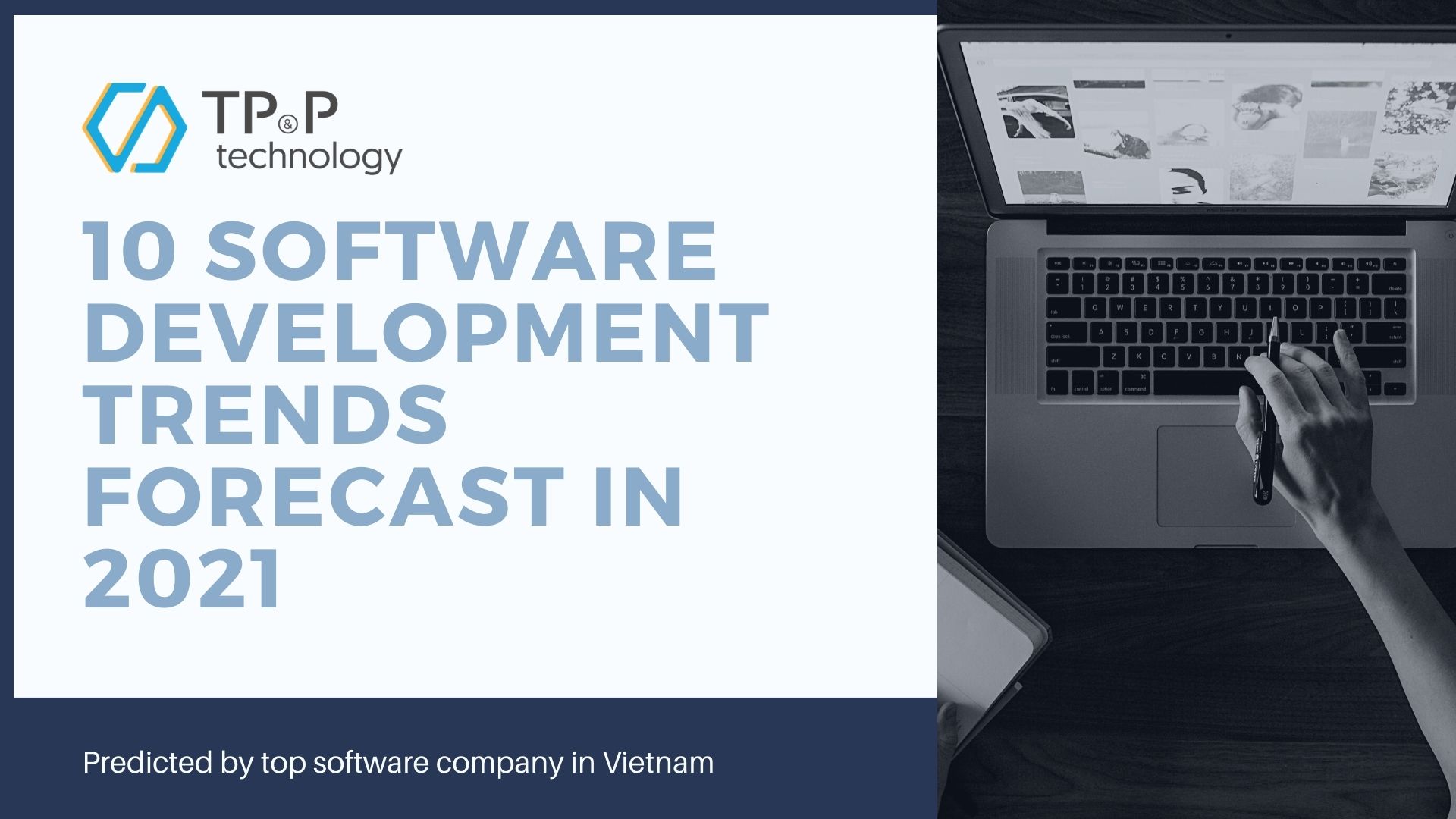
Top 10 Software Development Trends Forecast In 2021
2020 is a black sheep in modern history, we have not experienced a global pandemic like COVID-19 since 2009 (read this article to know about the seven major pandemics in human history). It affects all countries around the world, all industries, and more importantly, almost all human individuals on our planet earth.
Despite the new coronavirus variation, we are entering the new year with optimism and hope since we already have experience of how the virus can affect us and know how to protect ourselves and others around us against the spread of COVID-19.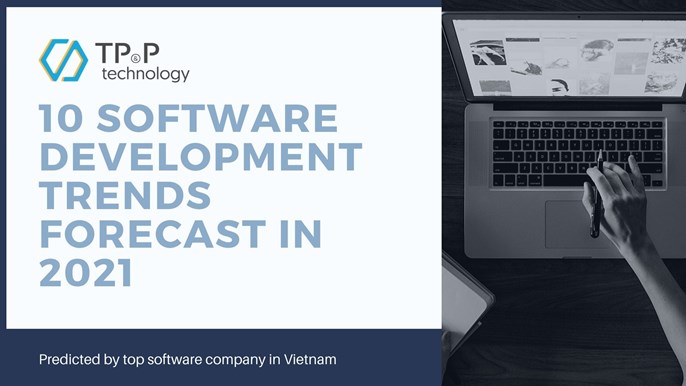
For the software development industry, 2020 is a significant year with many breakthroughs in different areas. COVID-19 has significantly accelerated digital transformation and the trends of digital transformation will be more obvious.
In this article, we will discuss the 10 notable software development trends that are expected to take place this year. If you want to know more about how the software industry will change in 2021, please continue reading.
*NOTE: Vietnam Software Development industry has attracted a lot of attention from tech giants and small-and-medium enterprises globally with the talented and hard-working workforce, the ability to keep up with the latest technologies, and an incredible cost-savings option.
1. Cloud adoptions everywhere
Because of the COVID-19, most industries were hit hard; however, the cloud is a forerunner industry, and it is actually stronger than ever during the pandemic. If there are any doubts and uncertainties regarding cloud adoptions, COVID-19 has eliminated this.
A global-scale crisis like coronavirus shows that we need the cloud to both upscale and downscale, i.e., when the demand for services drops significantly in the economic downturn. Looking at the tourism and transportation industry, they have to maintain expensive data centers even though their market has dropped 90 percent.
It is predicted that the global public cloud IT infrastructure will grow by 35 percent to $120 billion in 2021.
But no matter which industry you are in, planning cloud migration is not a redundant task since the entire world is moving to the cloud sooner or later. There will be a shortage of cloud-native engineers onwards; slightly off-topic, but you broaden your career prospect by earning a Cloud certificate if you’re an IT engineer. Amazon does offer free cloud computing skills training courses to 29 million people between 2021 - 2025.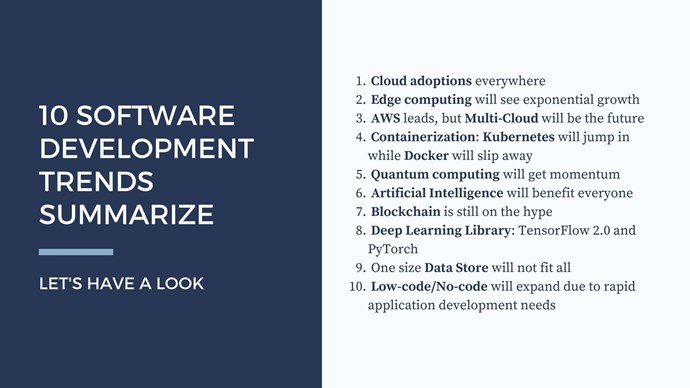
2. Edge computing will see exponential growth
In the public cloud, we want to have a centralized data center to provide data and compute power. But in many scenarios, we have different needs. For example, data and compute power that is near the end-users. Some are very low latency (5 to 20ms), high bandwidth, regulatory reasons, real-time use cases, smart terminal devices, etc.
Although edge computing is rather an old concept, and we have been using edge computing in content delivery networks (commonly known as CDN), it has become more popular in recent years. With the rise of connected devices (like autonomous cars, drones), online games, IoTs, smart devices, etc., edge computing will become a huge market attracting investments in 2021 and onwards. The rise of 5G mobile devices also affects the expansion of edge computing.
In 2021, the two industrial groups that will compete for a piece of market share in edge computing are public cloud providers like Amazon, Microsoft, Google (read the detail here) and the one that already has the edge infrastructure like Telecommunications Companies, data center providers, and network providers.
In this regard, for the public cloud providers group, Amazon is the pioneer in many services like AWS Snow family and AWS IoT Greengrass. Microsoft also provides edge computing services such as Azure Stack Edge and Azure Edge Zone. Google also uses Google Anthos to transfer its data center services to end-users.
For the one with existing edge infrastructure, if they can move quickly and take advantage of their infrastructure, they can find the opportunity to play the leading role in this competition. Hybrid cloud provider RedHat (IBM) will be the game-changing-factor with its hybrid cloud platforms OpenShift and OpenStack. In recent times, Samsung cooperated with IBM to develop edge computing solutions. More detail available about Samsung and IBM is available here: Samsung, IBM to develop edge computing, 5G and Hybrid cloud solutions for industry 4.0
3. AWS leads, but Multi-Cloud will be the future
Among public cloud providers, there is no doubt who is the leader: Amazon, who is leading the public cloud market with a market share of 32 percent.
Microsoft has a strong performance in its cloud products, achieving 48 percent annual growth last year. In the third quarter of 2020, Microsoft’s market share was 19 percent, while its market share in the third quarter of 2021 was 17 percent.
Currently, Google is the third-largest public cloud provider, with a market share of 7 percent in the third quarter of 2020.
In 2021, it is expected that Alibaba will replace Google in 2021. Additionally, the multi-cloud initiative will gain greater momentum in 2021. Many companies have also turned to a multi-cloud strategy. The Central Intelligence Agency (CIA) recently awarded its cloud contracts to multiple cloud vendors instead of a single vendor.
Amazon was not willing to join the multi-cloud initiative to protect its market share. But as we had seen what happened with Microsoft, industry, and community are stronger than the largest single company. As a result, recently, AWS has silently joined the multi-cloud initiative.
The Cloud Native Computing Foundation (CNCF) plays a critical role in the multi-cloud movement and can be said to have surpassed the Linux Foundation. This year, we can see more growth in it. Also, we will see more initiatives that provide API compatibility with popular cloud services from specific vendors. 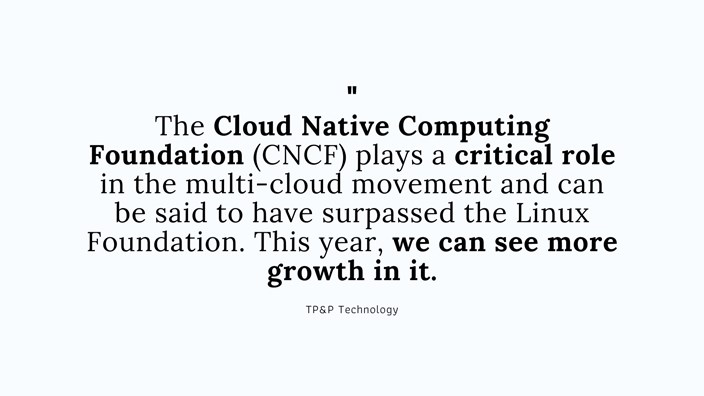
This is such good news for the entire industry. Companies can seamlessly deploy their application on multiple clouds.
4. Containerization: Kubernetes will jump in while Docker may slip away
Containerization, which is the core technology of cloud-native IT, no matter if it is a public cloud or a private one, or even edge computing. For several years, Kubernetes has become the leading container orchestration and management technology. Just like Linux ruled the data centers before, Kubernetes is ruling the public and private cloud. At first, Google was the dominant force behind Kubernetes, but now, almost all giant technological companies support Kubernetes.
All major public cloud providers now provide managed Kubernetes services, such as Amazon EKS, Azure AKS, Google GKE, and their managed containerization services.
In 2021, we expect to see more adoption of Kubernetes because it is the component of the hybrid-cloud and multi-cloud strategy. Non-traditional enterprise applications such as AI/ML, databases, data platforms, serverless, and edge computing applications will also likely be transferred to Kubernetes.
Need help with your projects? Contact TP&P Technology - Top Vietnam Software Outsourcing Company Today
On the other hand, Docker is slowly losing its charm as modern technology. There have been a number of initiatives to standardize container formats and runtimes, two of which have received a huge boost in recent years, one is the Container Runtime Interface (CRI) led by Kubernetes, one is the Open Container Initiative (OCI) led by the Linux Foundation.
Recently, Kubernetes has announced that it is deprecating the use of Docker container runtime. Since Kubernetes is a giant in the container ecosystem, 2021 will be the beginning of an end for Docker. On the bright side, CRI and OCI will gain greater development momentum in 2021, especially CRI-based containers that will experience tremendous explosive growth in 2021.
Since Kubernetes is a giant in the container ecosystem, 2021 will be the beginning of the end of Docker. On the bright side, CRI and OCI will gain greater development momentum in 2021, especially CRI-based containers that will experience tremendous explosive growth in 2021.
5. Quantum computing will get momentum
Quantum computing is the most revolutionary technology. Just like a digital computer, it has the potential to affect every field. Look at it from another angle: if we treat today’s most advanced supercomputer as normal humans, a chess player or an 8th-grade math student, then quantum computing is a supercomputer like a genius who can simultaneously play against 50 average chess players.
In 2020, quantum computing has made some major breakthroughs and advancements. In June 2020, Honeywell said it had built the world’s most powerful quantum computer, breaking the previous record created by Google.
Many governments and technology giants are exploring and investing in quantum computing. Google and IBM are the two biggest explorers and investors in this field. Google has launched an open-source library, TensorFlow Quantum (TFQ) for prototyping quantum machine learning models.
Considering its huge profits and unlimited possibilities, there will be some breakthroughs and amazing discoveries in computer quantum in 2021.
6. Artificial Intelligence will benefit everyone.
Artificial Intelligence (AI) is one of the most popular technologies recently, it has also made many breakthroughs in 2020. Another interesting trend is that artificial intelligence has begun to enter all industries is “AI for all.”
In 2021, natural language processing will make breakthroughs, and AI bot will be used to write articles and small applications.
Another interesting development is AutoML 2.0, which supports engineering automation. In 2021, full-cycle artificial intelligence automation will make significant progress.
AI is not AI without prejudice, and ethical AI is becoming more and more attractive. Another major trend in the AI sector is XAI (explainable artificial intelligence), which will need an explanation for some AI certain decisions.
AI will also be widely used in the aviation industry in 2021 and beyond. Just a while ago, the U.S Air Force used AI as a co-pilot to fly an aircraft.
It is expected that by 2021, Artificial Intelligence (AI) Solutions will have many exciting innovations and democratization.
7. Blockchain is still on the hype
Blockchain, which is widely known as a distributed ledger, is one of the main disruptive technologies developed in recent years. As far as concerned, it has the big potential to bring changes to all industries.
Many rogue organizations use the popularity of Bitcoin to create fraudulent projects to deceive people who want to get rich in a short period of time. Therefore, some governments are interfering in cryptocurrencies to prevent fraud.
Facebook is shifting its Libra cryptocurrency but faces huge regulatory pressures in 2020. Other open-source blockchains, such as Etheruem, are putting code into blocks so that it can be used in smart contracts. This is the future of blockchain.
In 2021, it is predicted that blockchain technology will be used more as a smart contract mechanism, making a major explosion in 2021.
8. Deep Learning Library: TensorFlow 2.0 and PyTorch
Google and Facebook are known as the two dominant players in the field of Deep Learning and Neural Network. Google’s main business is its searching capability, and it is the innovative leader in the field of natural language processing. Facebook’s main business is surrounded by its social network, and it has to process images, videos, and text. In the field of image processing, Facebook is a technological leader with many innovations.
TensorFlow was the leading library in the field of deep learning before PyTorch was released in 2016. Instead of static graphs, PyTorch uses dynamic graphs and is more Python-friendly. In response, Google created TensorFlow 2.0 in 2019, which replicated many features of PyTorch. It also perfectly integrates with Google’s Collab, a modern and powerful notebook. Since then, Google TensorFlow 2.0 has become more and more popular. 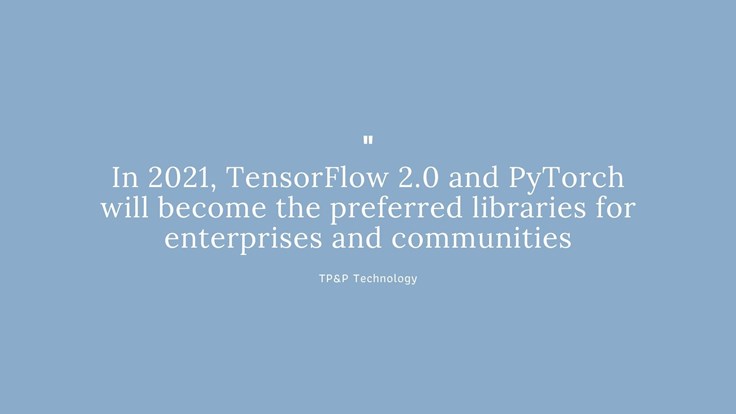
According to Stack Overflow Developer Survey 2020, TensorFlow is the most popular deep learning framework. On the other hand, developers like to work with PyTorch due to its better Developer Ergonomics.
In 2021, TensorFlow 2.0 and PyTorch will become the preferred libraries for enterprises and communities. Companies that have a TensorFlow code-base or want to use Collab notebooks should use TensorFlow 2.0 Companies or individuals who have just started using deep learning or want to continue using Jupyter Notebook should go with PyTorch.
9. One size Data Store will not fit all
The future of modern databases is full of choices and wide-ranging options, like the classic SQL databases, mainly four databases: MySQL, Oracle, MS-SQL, PostgreSQL; and the NoSQL databases, which composes a series of Document, Key-Value, Wide-Comn, Time-series, Search, and Graphs. Also, there are many other types of Data Stores.
We recently saw the so-called Global Distributed ACID transaction database or NewSQL database. Google has become the leader in this field with Google Spanner, which is the first horizontal read/write scalable ACID compatible database. Amazone also has a horizontally scalable ACID compatible database.
By 2021, the data storage ecosystem will remain unchanged, with many options. There will be no Mater database that can satisfy all purposes. Besides, after careful consideration, choosing the right database will be very challenging.
*Further reading about the top 10 databases to use in 2021.
Many well-known databases have changed their licenses like MongoDB, Cassandra, Redis, etc, because the hyper-scale cloud providers have abused their innovative technologies and made money without a return.
This trend will continue throughout 2021 when other startups or innovative companies will use more restrictive licenses to protect them from cloud providers.
10. Low-code/No-code will expand due to rapid application development needs
Because of the rise of rapid digital transformation demands, a big gap in terms of supply and demand for software engineers also increases. Although thousands of new developers are joining the global workforce annually, it is still not enough. Recently, the low-code/no-code initiative is catching a lot of attention.
There are many low-code/no-code platforms available on the market, mainly in web development. Their success has also paved the way for the development of low-code/no-code in other areas: no-code application development, no code AI, no code ML. LC/NL tools can motivate businesses or people with great ideas.
*We recommend you to read this article to know which technology trends (RPA, Low-code/No-code, SaaS, Custom Software Development) are suitable for your business needs.
In addition, many public cloud providers are offering LCNC services for quick app-building, such as Microsoft’s Power Apps, Google’s AppSheet, AWS’s Honeycode.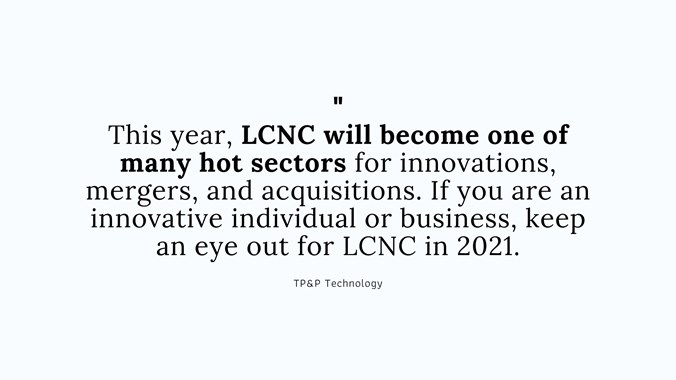
This year, LCNC is expected to become one of many hot sectors for innovations, mergers, and acquisitions. If you are an innovative individual or business, keep an eye out for LCNC in 2021.
Side-note
According to the facts, current trends, and data, we can predict the most critical software development trends for 2021. However, the whole software development industry is much wider, so we couldn’t cover all points; therefore, we recommend you to follow our blog to get updates as well as more insights that pertain to the information technology sector in general and the software development sector in particular.
In the future, we will write more articles providing you with information about software development since we know that it is one of your concerns when reaching out to us. These posts are condensed from our experience.
TP&P Technology is one of the top software companies in Vietnam. With 16 years of experience in the field of software development outsourcing, you can trust us with your IT & digital transformation projects.
Contact us now to know more about how we can help you. We provide both IT consulting services and software development outsourcing along with software testing & QA services.



